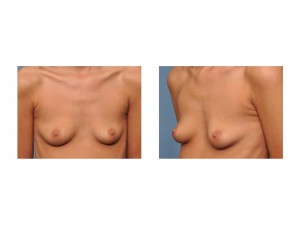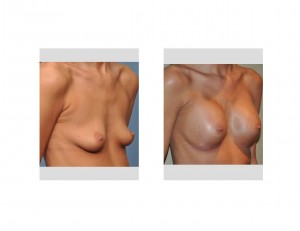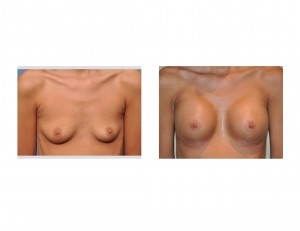Background: The dramatic effect of an implant on the size and shape of the breast is more than well known. Expanding the breast skin in three dimensions elevates the nipple and widens the base of the breast, creating a fuller and more youthful breast appearance. Often overlooked is the effect of breast augmentation on the shape and contour of the chest wall. How it changes the look of the sternum in the midline and the ribs on the sidewall can be equally significant.
Pectus excavatum presents in a range of chest wall deformities, all marked by an abnormal sternal concavity and depression. Most severe pectus excavatums are treated very successfully today by the Nuss repair, bring the sternum out and relieving any underlying pulmonary compression. But numerous more minor expressions of pectus excavatum exist that do not warrant surgery as well as cases of undercorrection that can appear very similar. It is not rare to see females with these more mild pectus excavatum sternums for breast augmentation. An interesting question, often posed by the patient, is whether enlarged breasts will make the sternal concavity look worse.

Because of her lack of any significant breast tissue, she opted for silicone gel implants to minimize rippling and outlining of the breast implants. Her breast base diameter was a small 12.5 cms. She wanted to two important outcome issues that had extreme relevance to her existing chest wall deformity; would breast implants give her cleavage and would they make her sternum look worse or more sunken in.
Her breast augmentation procedure was done through a standard 3.5 cm long incision placed in where her new lower breast crease would be created. Using her existing breast crease would end up making the incision visible as the implant needs to sit lower to keep the final breast volume from being positioned too high. Her pectoralis muscle was very thin but otherwise normal. Silicone gel breast implants of 375cc size were inserted. Release of the lower attachments of the pectoralis was done to get the implants properly positioned low and as close as possible to the sternum.

Case Highlights:
1) It is not uncommon to see women seeking breast augmentation that have some degree of a pectus excavatum sternal deformity.
2) Breast implants will usually not make the sternal concavity look worse. The fear that it will appear deeper because of breast enlargement is unfounded.
3) Getting cleavage from breast implants in a concave sternum is not obtainable in most affected patients. Aggressive muscle release or the use of a large implant that exceeds the breast base diameter in attempt to get ‘natural’ cleavage should be avoided.
Dr. Barry Eppley
Indianapolis Indiana



